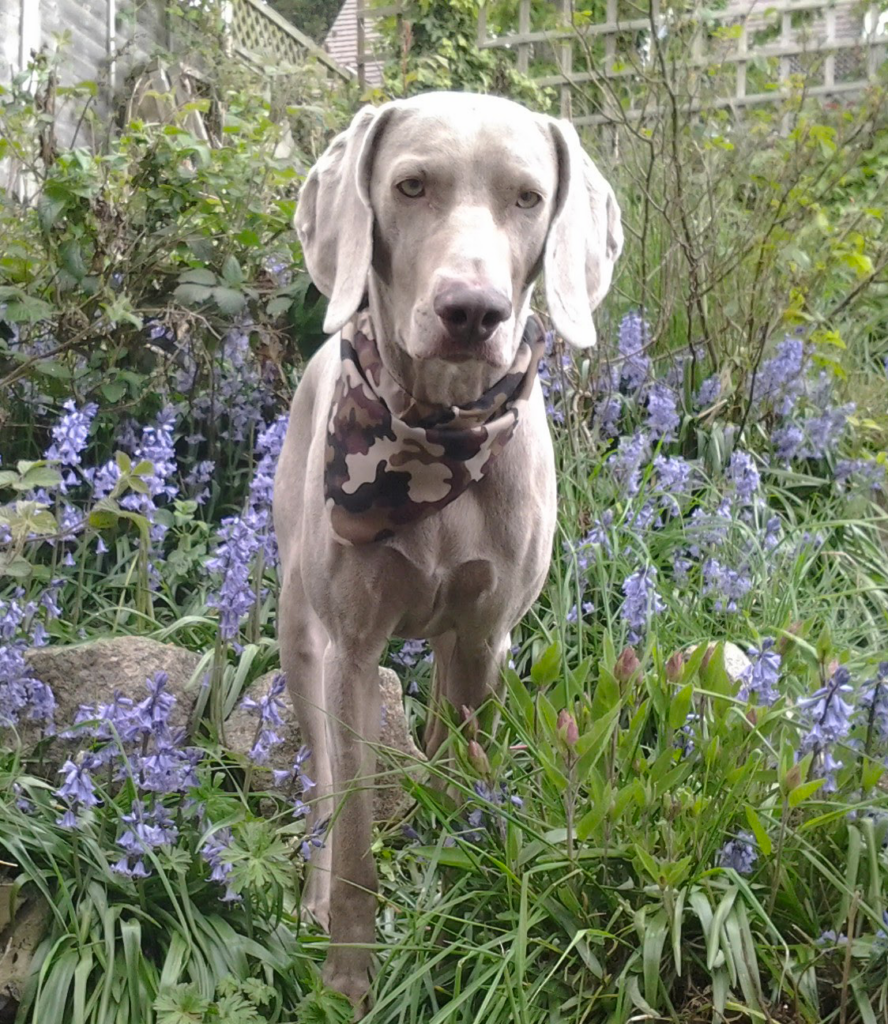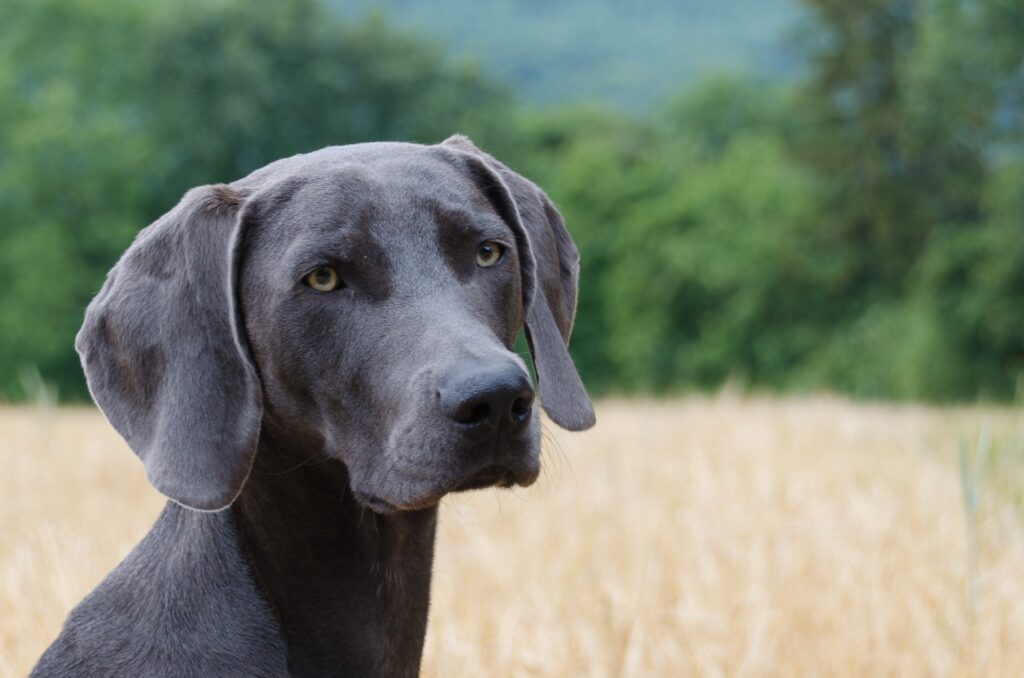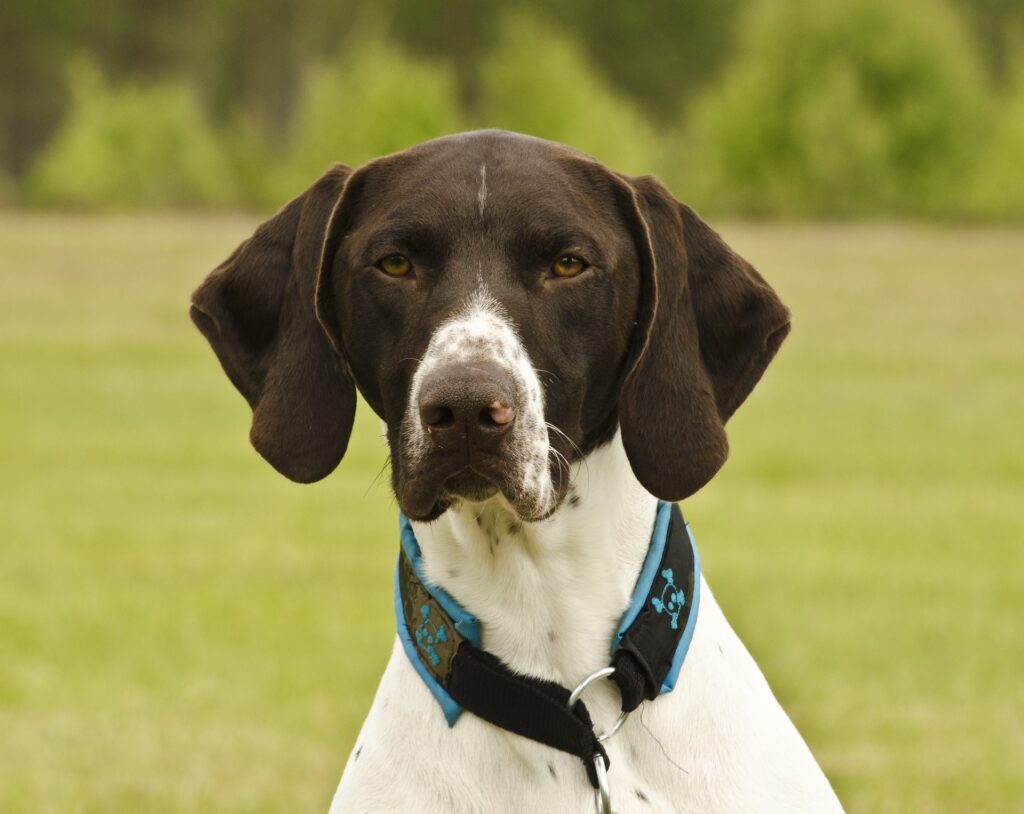The Weimaraner’s one most defining physical characteristic is it’s strangely iridescent pale brown grey colour that varies a great deal depending on the light, and can almost make the dog appear almost metallic under bright lights.
The ‘blue’ Weimaraner is increasing in numbers in the UK, and breed clubs and champions of the breed are not happy. ‘Blue’ Weimaraners can be registered as a pedigree Weimaraner with the UK Kennel Club, but will be defined as ‘colour not recognised’… which basically means you will automatically be disqualified if you were to turn up at a KC regulated dog show.
Breed enthusiasts point back to the genetics of the Weimaraner and suggest that ‘blue’ is not possible without there having been some outcrossing*.
The colour is, as described by the UK Kennel Club:
“The only correct colour is grey. Silver grey preferable. Shades of mouse or roe grey are acceptable; blending to lighter shade on head and ears. Dark eel stripe frequently occurs along back. Whole coat gives an appearance of metallic sheen”
So what is “grey”? or even “silver”?
(Or gray, if you are from elsewhere in the English speaking world)…
In the Cambridgeshire dictionary, ‘grey’ is described:
of the colour that is a mixture of black and white,
and ‘silver’:
(of) a bright grey-white color
But the colour of the Weimaraner is not ‘grey’, or ‘silver’…
The *silver* Weimaraner

BLACK
SILVER
BROWN
WEIMARANER



*on white background
A *blue* Weimaraner



From the gradients here, you can clearly see that it is *actually* (as in technically) the blue Weimaraner that fits the colour description of ‘grey’, or silver grey.
So, what about that ‘metallic sheen’?
In both colour variations, the pigment of the coat is dilute.
I guess a good way of explaining this might be that if you were to pick up a sealed bottle of orange squash, you could not see through the bottle. The content of the bottle is dense in pigment so rendering the bottle completely opaque.
When you pour the orange into a glass, and then add water, you dilute the density of pigment and you can see through the glass. The opacity is reduced. The same is true of white hair: Consider a bottle of milk. Add water to milk and the opacity is reduced. The hair shaft itself, like a glass of water without any pigmentation, is transparent.
The colouring of the Weimaraner is a less dense pigment than in a brown or black dog, such as the liver or black German Shorthair pointer. So with less density of pigmentation, the hair itself, like glass, picks up and reflects light, when there is less light, on a cloudy day or in a dark room, the dog appears darkerthan it does in a well lit situation.
Another thing to note is that, in the ‘blue’, while there is some dilute, there is less dilute than you would expect in a Weimaraner of correct colour. The blue dogs are of a heavier pigmentation density.
Here’s a German Shorthair Pointer (image from pixabay): The brown pigmentation is dense, so shows a solid colouring with a solid white pigmentation. Some of the finer hairs around the nose carry less pigmentation and appear more ‘glassy”.

To be continued… thoughts welcome! ..further musings all to be tidied up:
Things are complicated further in that several other breeds which are more commonly seen than the Weimaraner have different colour names for similar colour descriptions. A blue Staffordshire Bull Terrier is a dilute of either black or brown, or even brindle (both black and brown stripe), is a catch all colour name for any dilute or merle (pigmentation faded into white, like orange squash + milk = pale orange) in poorly bred French Bulldogs and XL breeds. i believe Shar peis also have various colour names for different dilutes, including blue and lilac.
As I see it, things are complicated further in that in all the 20+ years I have been an enthusiast of the Weimaraner as a breed, Blue has always been an extremely popular call / pet name for male dogs of correct colour.
So why aren’t the breed clubs and breed enthusiasts happy about blues?
- Where did the blue Weimaraner come from… the history of the Blue Weimaraner is pretty well spelt out here: A History of the Blue Weimaraner | Blue Weimaraner Today
While personally, I have no problem with outcrossing to similar type breeds when there is a health issue of concern, (as was the case in the Dalmatian and a condition known as hyperuricosuria, read more here: https://www.vin.com/apputil/content/defaultadv1.aspx?pId=11340&id=5101841), what makes a breed unique is it’s characteristics, and bringing other breeds in will not only affect the outward characteristics of the dog, but also its inherited temperament and drives.
The Hungarian Vizsla (Wire and Shorthair), the German Shorthair Pointer and to some degree the Bracco Italiano are all quite similar breeds, and most people referring to this site to help them decide if a Weimaraner might suit them, are no doubt also looking at these breeds. I’ve met many of these over the years, and all nice dogs, but in character, they are all so different. If I wanted any of the other breeds, I’d be writing about them here, but I am not. It’s the Weimaraner that is magic to me.
Breeding for aesthetic appearance alone has had an absolutely devastating effect on many popular breeds, that were once true working dogs that are today reduced to suffering terrible deformities and often barely able to run for a ball.
A breeding programme true to the origins of the breed is really the only way to ensure that the breed retains its unique characteristics. The *blue* weimaraner simply was not part of that.
Some people may feel differently and talk about the heritage and tradition. To me, its solely about ensuring our Weimaraners stay true to the magnificent creatures that they are